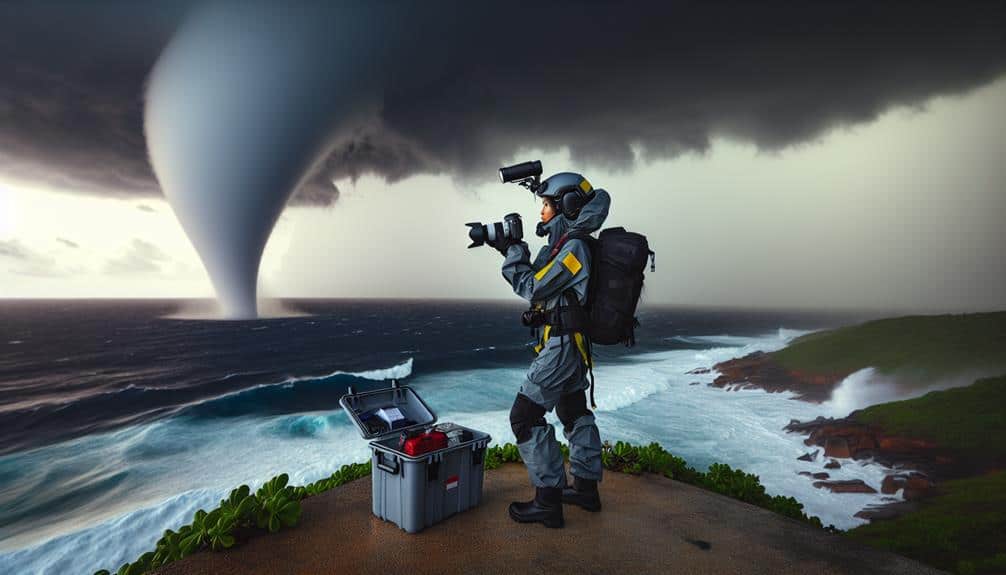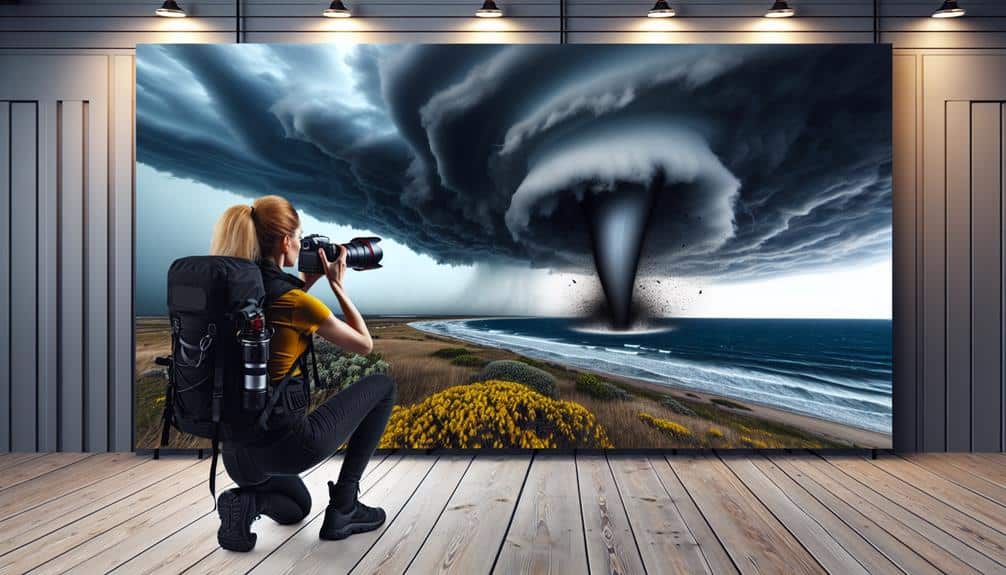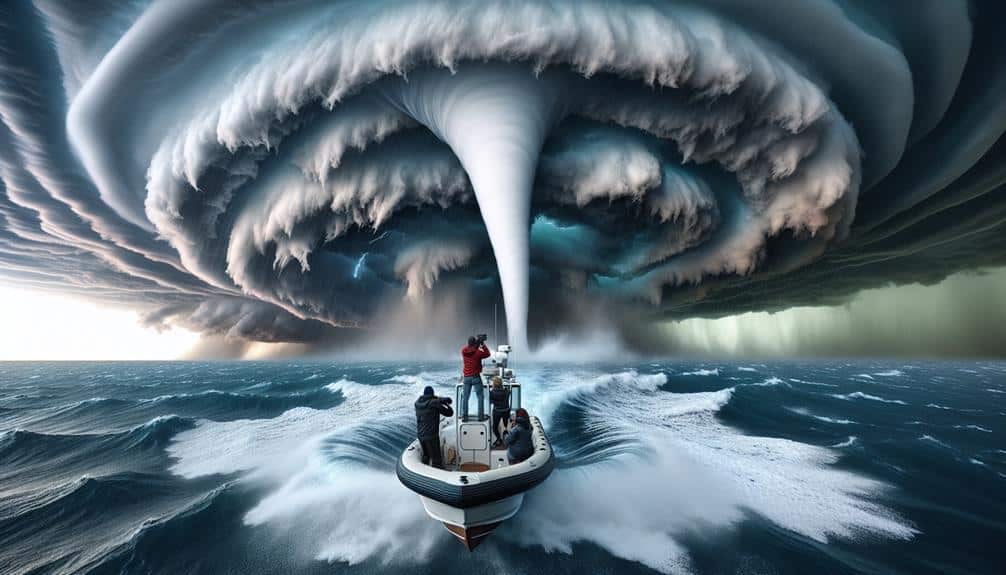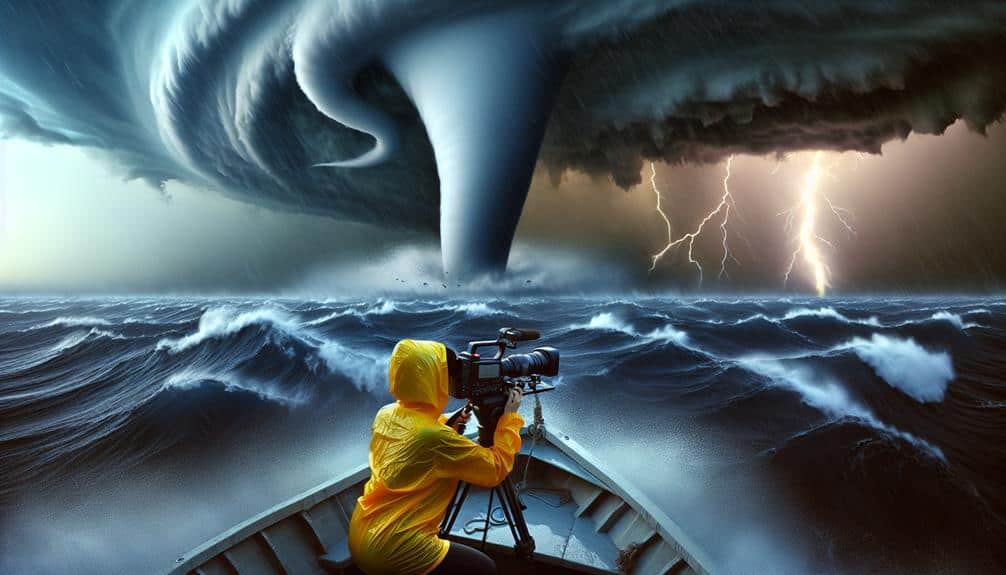As storm chasers, our mission to capture waterspouts depends on using high-definition sensors, weather-sealed cameras, and durable safety gear. We rely on meteorological models, satellite data, and Doppler radar to forecast and locate prime areas like the Florida Keys and Great Lakes. Essential gear includes DSLR or mirrorless cameras with rapid burst rates and telephoto zoom lenses for distant shots. Safety protocols, including emergency plans and hazard assessments, are vital. By combining thorough preparation with advanced technology, we ensure both stunning captures and safety in the field. Join us to explore these mesmerizing natural phenomena more deeply.
Key Points
- Use high-resolution, weather-sealed cameras with telephoto zoom lenses to capture distant waterspouts clearly.
- Monitor meteorological data, including sea surface temperature and wind shear, for accurate waterspout forecasting.
- Wear waterproof clothing, high-visibility jackets, and slip-resistant boots for safety during storm chasing.
- Set camera shutter speed to at least 1/1000th of a second for sharp images of dynamic waterspouts.
Understanding Waterspouts
To understand waterspouts, we must first distinguish them from tornadoes, noting their unique formation over bodies of water. Unlike tornadoes, which primarily form over land, waterspouts emerge over water surfaces, typically in tropical and subtropical regions. This distinction is essential as it underscores the formation process: waterspouts develop from cumulus clouds and are often associated with severe thunderstorms. They begin with a dark, flat base cloud that funnels downward, forming a thin, swirling column of air and water mist.
Waterspouts exhibit unique characteristics: they can be categorized into two types—fair-weather and tornadic. Fair-weather waterspouts are more common and less intense, forming in light wind conditions, whereas tornadic waterspouts are stronger and develop from severe thunderstorms, akin to land-based tornadoes.
Interestingly, waterspouts have inspired numerous myths and folklore. For instance, ancient mariners often viewed them as omens or sea serpents, reflecting a blend of awe and fear. Despite these myths, modern meteorology allows us to demystify waterspouts with data-driven insights.
Essential Gear
To effectively capture waterspouts, we need to prioritize our camera and lens selection, ensuring high-resolution sensors and weather-sealed bodies.
Equally important, we must equip ourselves with protective weather gear to withstand harsh conditions.
Data shows that proper equipment enhances the quality and safety of our fieldwork.
Camera and Lens Selection
Selecting the right camera and lens is vital for capturing high-resolution images of waterspouts, as the unpredictable nature of these phenomena demands gear that excels in both speed and clarity. We recommend using a DSLR or mirrorless camera with high burst rates to capture rapid sequences. The sensor size should be full-frame for best low-light performance and greater detail.
For lens selection, a telephoto zoom lens with a focal range of 70-200mm provides the necessary zoom capabilities to capture distant waterspouts. Opt for the lens to have a wide aperture setting, ideally f/2.8, to handle varying light conditions and to achieve shallow depth of field when needed. Incorporating lens filters, such as neutral density (ND) filters, helps manage exposure in bright conditions.
Tripod stability is essential for sharp images, especially during long exposures or when shooting timelapses. Choose a sturdy, lightweight tripod to maintain freedom of movement without sacrificing stability. Additionally, using a remote shutter release minimizes camera shake.
Protective Weather Gear
Equipping ourselves with robust protective weather gear is critical for ensuring both safety and comfort while photographing waterspouts in unpredictable and often harsh conditions. Waterproof clothing is non-negotiable; it shields us from torrential rain and maintains our core body temperature.
High-visibility jackets and pants enhance our presence in low-light conditions, allowing us to remain visible to fellow storm chasers and emergency responders.
Helmet protection is another indispensable component. A high-impact, wind-resistant helmet guards against flying debris propelled by the intense winds often associated with waterspouts. The aerodynamic design of these helmets minimizes wind resistance, enabling us to move swiftly and efficiently in volatile weather.
Footwear should be both waterproof and slip-resistant. Boots with deep treads provide stability on wet, uneven surfaces, ensuring our mobility isn't compromised.
Layering thermal undergarments beneath our outer shell can further insulate us against the cold, maintaining our focus on capturing the perfect shot rather than our discomfort.
Safety Precautions

When capturing waterspouts, we must prioritize safety by understanding the dynamic and unpredictable nature of these weather phenomena. First and foremost, establishing robust emergency protocols is essential.
Before heading out, we conduct thorough storm preparation, ensuring our vehicle and equipment are in top condition. We also familiarize ourselves with local emergency services and evacuation routes to respond swiftly if the situation escalates.
Risk assessment is a fundamental step. We analyze meteorological data, including wind patterns and water temperatures, to gauge the likelihood of waterspout formation. This data-driven approach enhances our hazard awareness, allowing us to make informed decisions in real-time.
We should never underestimate the power of a waterspout; they can rapidly intensify, posing serious threats to our safety.
To mitigate risks, we maintain a safe distance from the waterspout, aiming for a vantage point that balances visibility with personal safety. We avoid positioning ourselves directly downwind or in low-lying areas prone to flash flooding.
Additionally, we use reliable communication devices to stay updated on weather changes and maintain contact with other storm chasers.
Ultimately, our goal is to capture stunning footage without compromising our well-being. By adhering to these safety precautions, we can enjoy the thrill of storm chasing while minimizing potential dangers.
Forecasting Techniques
To forecast waterspouts effectively, we rely on a combination of advanced meteorological models and real-time satellite data. By integrating these tools, we can identify atmospheric conditions conducive to waterspout formation. Meteorological models allow us to simulate weather patterns and predict variables such as sea surface temperature, wind shear, and humidity levels. These factors are critical in determining the potential for waterspouts.
Satellite imagery provides us with a bird's-eye view of developing weather systems. High-resolution images enable us to monitor cloud formations and track changes in the atmosphere. When we see the characteristic cumulus clouds forming over warm water, it's a strong indicator that a waterspout might develop. By analyzing these images in conjunction with meteorological data, we can pinpoint likely hotspots for waterspout activity.
We use real-time data to update our forecasts quickly, ensuring accuracy. This dynamic approach allows us to be agile, making adjustments as new information comes in.
The freedom to chase the storm relies heavily on these forecasting techniques. By leveraging advanced technologies and data, we maximize our chances of capturing stunning waterspout phenomena while staying safe and informed.
Best Locations

Let's focus on the best locations for capturing waterspouts by examining coastal hotspots, seasonal timing, and local weather patterns.
We'll analyze data showing that waterspouts frequently occur in areas like the Florida Keys and the Great Lakes during late summer.
Coastal Hotspots
Many coastal regions, particularly the Florida Keys and the Great Lakes, offer prime conditions for observing and documenting waterspouts. The Florida Keys, with their warm, moist air and shallow waters, create an ideal environment for waterspouts to form. Using precise chasing tactics, we can position ourselves at strategic vantage points along the coastline. Essential equipment includes high-resolution cameras, anemometers, and GPS devices to track movement and intensity.
In the Great Lakes region, the combination of cold air masses meeting warmer lake surfaces often triggers waterspouts. Expert advice suggests monitoring satellite imagery and Doppler radar data to predict their formation. Techniques such as setting up early and maintaining a safe distance from the phenomenon are pivotal for capturing high-quality footage while ensuring safety.
Our freedom to explore also means adhering to safety protocols. We recommend using marine radios to stay informed about sudden weather changes and employing drones for aerial perspectives.
Seasonal Timing
Determining the best locations for capturing waterspouts hinges on understanding the seasonal timing of their formation, which varies by region and is influenced by specific meteorological conditions. Knowing when and where these phenomena are most likely to occur allows us to plan our chase strategies effectively and increases our chances of encountering them under ideal conditions.
Waterspouts are most commonly observed in the following regions during their respective peak seasons:
- Great Lakes (Late Summer to Early Fall): The convergence of warm lake water and cooler air masses creates perfect conditions.
- Florida Keys (Late Spring to Early Fall): Warm ocean waters and frequent thunderstorms provide a fertile ground for waterspout formation.
Meteorological factors such as sea surface temperature anomalies, wind shear, and atmospheric instability play vital roles in the formation and frequency of waterspouts. We utilize sophisticated storm tracking tools to monitor these variables and adjust our chase strategies accordingly.
Local Weather Patterns
Identifying the best locations for capturing waterspouts requires a thorough analysis of local weather patterns and their interaction with regional geography. We need to focus on areas where specific atmospheric conditions are conducive to waterspout formation. Coastal regions with warm water surfaces, such as the Florida Keys and the Great Lakes, are prime locations. Here, the interplay between warm water and cooler air masses frequently generates the necessary thermodynamic instability.
By examining climate data, we can pinpoint times and places with a higher likelihood of waterspout activity. For instance, historical storm tracking reveals that the Gulf of Mexico frequently experiences waterspouts during late summer, when sea surface temperatures peak. Additionally, areas like the Mediterranean Sea benefit from similar conditions, making them hotbeds for this weather phenomena.
We should also consider atmospheric conditions such as wind shear, humidity, and temperature gradients. High-resolution weather models and real-time satellite imagery provide invaluable tools for monitoring these factors. By leveraging this data, we can enhance our predictive capabilities, allowing us to chase waterspouts more effectively and safely.
Ultimately, understanding local weather patterns gives us the freedom to anticipate and capture these mesmerizing natural events with scientific precision.
Photography Tips
To capture the detailed nuances of waterspouts effectively, we should use a high-speed shutter to freeze the rapid motion of the swirling water and wind. By setting our cameras to a shutter speed of at least 1/1000th of a second, we can achieve sharp, detailed images even under dynamic conditions.
Proper lighting techniques are vital for showcasing the power of these natural phenomena. Utilizing a polarizing filter can help reduce glare and enhance contrast, making the waterspout more defined against the sky.
Regarding composition tips, framing the shot with a wide-angle lens allows us to capture the full scale of the waterspout and its surrounding environment, adding depth and context to our images.
When it's time for post-processing, using sophisticated editing software like Adobe Lightroom or Capture One can greatly enhance our photos. We should focus on adjusting the contrast and sharpness to highlight the intricate structure of the waterspout.
- High-Speed Shutter: Essential for freezing motion and capturing details.
- Polarizing Filter: Reduces glare and enhances contrast.
Documentaries on Chasing Waterspouts

Exploring the thrilling realm of waterspout documentaries, we immerse ourselves in the advanced techniques and cutting-edge technology filmmakers use to capture these awe-inspiring weather phenomena.
Utilizing drone footage has transformed the way we document waterspouts, offering unparalleled aerial perspectives that were previously unimaginable. Drones equipped with high-resolution cameras allow us to safely record these dynamic events from multiple angles, providing detailed visual data and a deeper understanding of their structure and behavior.
Time lapse videos are another crucial tool in our arsenal. By condensing hours of footage into mere seconds, time lapse captures the formation, evolution, and dissipation of waterspouts in a visually captivating manner. This technique not only showcases the fleeting beauty of these storms but also assists researchers in identifying patterns and deviations within the data.
We also utilize advanced meteorological instruments and software to predict and pursue waterspouts more efficiently. High-resolution radar and satellite imagery enable us to pinpoint potential waterspout locations, increasing our likelihood of capturing these elusive phenomena on film. By integrating these technologies, we produce documentaries that not only excite viewers but also contribute valuable insights to the scientific community, all while experiencing the freedom of exploring nature's most dramatic exhibitions.
Frequently Asked Questions
How Can I Join a Storm Chasing Community?
To join a storm chasing community, we should research online forums and social media groups, attend meteorological conferences, and participate in local events. These activities provide networking opportunities and valuable data-driven insights into storm chasing techniques.
What Are the Best Seasons for Spotting Waterspouts?
We should focus on late summer and early fall for waterspouts frequency in ideal locations like the Florida Keys. These seasons have implications for marine life and ecosystems, potentially disrupting habitats and affecting local biodiversity.
Do Waterspouts Have Any Environmental Impacts?
Ironically, while waterspouts may look mesmerizing, they can disrupt marine life and ecosystems. They alter weather patterns and ocean currents, leading to potential environmental impacts. So, yes, waterspouts do have notable effects on our natural surroundings.
Can Waterspouts Occur in Freshwater Lakes?
Yes, waterspouts can occur in freshwater lakes. Coastal versus inland waterspouts differ mainly in location, but both involve tornado formation in lakes, driven by similar atmospheric conditions. We should explore these phenomena for scientific insights.
Are There Guided Tours for Amateur Storm Chasers?
Imagine the thrill of nature's dance. Yes, there are guided tours for amateur storm chasers. Experienced guides guarantee safety precautions, recommended gear, and take us to popular destinations, balancing scientific accuracy and the wild freedom we crave.


